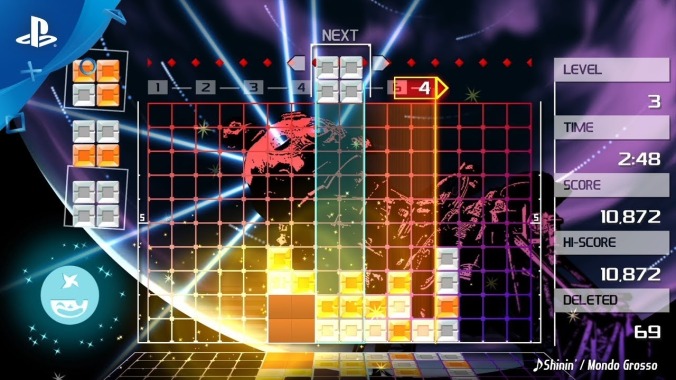Lumines belongs in the pantheon of all-time great puzzle games

Every Friday, A.V. Club staffers kick off our weekly open thread for the discussion of gaming plans and recent gaming glories, but of course, the real action is down in the comments, where we invite you to answer our eternal question: What Are You Playing This Weekend?
Lumines Remastered
Here’s a weird one I’ve been chewing on: What makes a great puzzle game? To be clear, I don’t mean narrative puzzle games like Portal or The Witness or Limbo, but rather more pure, abstract puzzlers, à la Tetris or Drop 7 or Bejeweled. My initial answer would be this: 1) The game’s rules are fairly easily learned; 2) Those rules constrict, scaling up to an almost impossible difficulty; and 3) These qualities create a sort of perpetual playability, often one match right after the next. If you fire up Tetris right now, it’ll click in just like it did the first time you played it decades ago, and by the time it’s over you’ll think, “Damn it, I’ve gotta play another round immediately.” Please do not fire up Tetris right now if you have anything to do today.
I’ve been thinking about this rubric lately because I’ve been playing a lot of Lumines, which, like everything else ever, was recently brought to the Switch. It’s my first time playing the game, though, and it frankly breaks all three of my rules right out of the gate. Sure, you’re just matching four tiles at a time, but the logic by which you chain these and clear them is byzantine. Once you’ve begun to understand—which is a matter of hours, not minutes—playing it is less vexing and more rhythmic, almost arcade-like in its twitchy demands. It contains a bunch of different modes—puzzle mode, “mission,” time attack, and so on—none of which seem even remotely interesting to me after a few polite attempts. The real action is in the Challenge mode, where runs frequently last 30 minutes or more. They end less out of inability than hubris; a devoted player could quietly clear blocks efficiently and slowly for an incredibly long time, but attempts to link big chains together 10 minutes in lead to an unplayable board 30 minutes later. It’s a weird, beautiful thing. I keep dying on what can only be described as “the cat song.”
The game is a mid-period work by Tetsuya Mizuguchi, who I’d put in the absolute top-tier of video game auteurs; his Rez and Child Of Eden are two all-timers, especially for people whose primary interest in playing games is doing so loudly and while high. (I anticipate his next project, a remake of Tetris, the way other people feel about, like, a new Elder Scrolls game.) Lumines is just as overpowering as those more overtly psychedelic games, full of flashing lights and weird rhythmic sound effects, turning even your cube rotations into elements in the percussive maelstrom. As usual for Mizuguchi, the attempt is to create a zen, synesthetic reaction between the music, the visuals, and the mechanics, and, as always with Mizuguchi, it works. Lumines is utterly transportive. I certainly can’t argue with its placement among the all-time great puzzle games, but it seems to be creating an argument among the other games in that hale pantheon. Why can’t more of them have a cat song, for example? [Clayton Purdom]
Mega Man X4
I was never a big Mega Man kid growing up, but I’ve been filling in that blind spot in recent years through emulation and Capcom’s wonderfully done anthologies. At this point, I’ve spent plenty of time with most of the big ones, but this week’s release of the Mega Man X Legacy Collection is giving me a chance to dip into that darker, anime-styled side of the series. I’m staying far away from Legacy Collection 2 and the series’ troubled back half right now. Instead, I’ve gone straight to Mega Man X4, which marked the series’ debut on the original PlayStation.
Compared to X3 and later entries, it’s built up a commendable reputation, and it’s easy to see why. By 1997, Capcom was one of the few studios still producing 2D games, and that expertise combined with the ever-growing power of gaming hardware led to some of the most lushly animated sprite-based games ever, like Street Fighter III. X4 doesn’t approach that level, and its grittier art style doesn’t hold up quite as well as the bright and cartoonish Mega Man 8, but it looks fantastic in its own right, especially the multi-layered environments and hulking bosses like Frost Walrus. This is also when the series really started leaning into its melodramatic storylines, and X4 presents its tale with anime cut scenes and some awesome character portraits. Everything I’ve heard about the story here makes it sound solid and surprisingly dark, but for now, as I get a feel for the levels and bosses, I’ve been mashing through all that hammy dialogue. Sacrilege, I know.
The other big draw is being able to play the whole game as Zero, trading Mega Man’s usual gun arm for a laser sword. That complete lack of range makes most portions of the game harder, but Capcom’s designers did a great job of building the stage to feel natural with both characters. And let’s face it, at the end of the day, laser swords are cool enough to be worth the struggle. [Matt Gerardi]